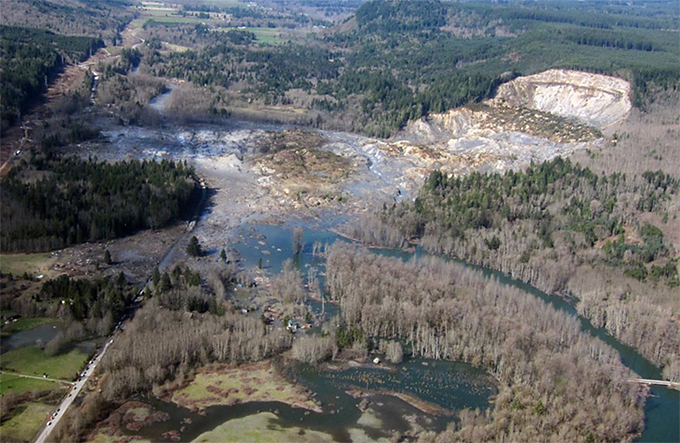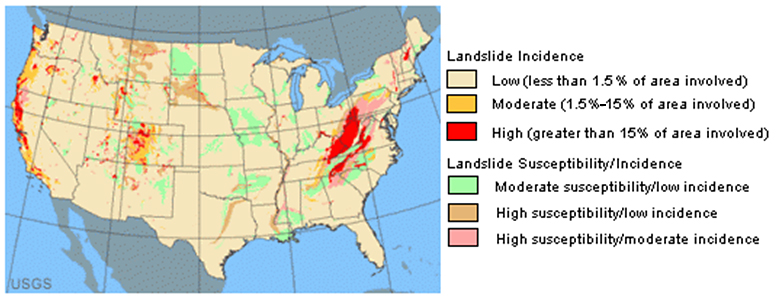
Credit: Mark Reid, USGS (public domain)
In 2014, a landslide began above the Stillaguamish River in Washington. In less than 5 minutes, it had buried a rural neighborhood. Forty-three people died, while eight more were carried along and lived to tell the tale. The slide dammed the river, which created a lake 2-and-a-half miles long.
As violent and frightening as landslides can be, they’re a natural part of the constant erosion and reformation of Earth. Most often, erosion is a very slow process—except about 400 times a year, when there’s a landslide.
They can creep downhill at just a few inches a day. Or they can build up speed, hitting nearly 200 miles an hour. Landslides can be massive, moving many cubic miles of earth in a single event. The wind they push in front of them can strip the leaves off of trees.
Landslides require both gravity and water. Natural erosion, or manmade activities like a roadcut, can make a slope overly steep or unstable. Too much water—from rainfall, snow, or even groundwater—can then weaken the internal cohesion of the soil.
After that, it’s just waiting for a trigger. That could be a natural tremor, from an earthquake or even thunder. Or it could be manmade, like vibrations from a mining operation or a train.
Studies of the Washington slide have helped us better understand all these contributing factors. And as our knowledge of landslides continues to grow, hopefully we’ll get better at getting out of their way.
Background
Synopsis: Landslides occur when slopes become unstable because of geologic or meteorological events. Instability can occur when slopes are oversteepened by natural causes like stream or beach erosion, or by human causes like road or construction excavation.
- On Earth, the erosional cycle is perpetual. Tectonic forces build tall mountains, then gravity and water work to tear them down toward a flat, featureless base level.
- In steep terrains, landslides are common as unstable slopes give way, seeking the lower potential energy of a flatter profile.
- Landslides are governed by gravity and slope instability; slope instability is controlled by the friction and density of earth materials on the slope.
- Water often plays a major role in setting the stage for a landslide. While minor amounts of water can increase the strength of soil, oversaturation pushes the grains apart and destroys their cohesion. Heavy rainfall or snowmelt, as well as changes in lake or groundwater levels, often factor into landslide scenarios. Even gradual changes in the distribution of water pressure within the slope materials can cause instability.
- Landslides need a trigger. Vibrations from earthquakes, volcanic activity, waves, and even thunder have caused events, as have manmade vibrations from mining, blasting, and passing trucks.
- Landslides might creep in inches per day, or they might rush downhill like a slurry of wet concrete. Landslides pick up speed and energy as they move downslope. Some slides have been reported to travel at speeds approaching 200 mph. Winds associated with the slides can be so forceful that they have been known to strip the leaves off of nearby trees.
- Landslides can move so much material that it is measured in cubic miles. Often materials run several hundred feet back up the other side of a valley. Landslides can block streams and create a lake, which can inundate communities in a valley.
- We hear about single landslide events on the news, but the true scale of landslide hazards requires a look at the bigger picture. In the United States, landslides cause 25–50 deaths and more than $1 billion in damages per year, but globally the impact is much larger—in 2016, there were 444 recorded landslide events, 2250 deaths, and $2–4 billion in damages. Surprisingly, of these, only 5 landslides and 10 deaths were associated with earthquake activity.
- On March 22, 2014, at 10:37 a.m. local time, a large landslide occurred 4 miles east of Oso in Washington State. A portion of an unstable slope collapsed in two stages, sending mud and debris across the North Fork of the Stillaguamish River at up to 40 mph. In less than 5 minutes, the landslide buried a rural neighborhood and covered an area of about 1 sq mile with the equivalent of 600 football fields filled 10 ft deep with mud. Forty-three people were killed, and 49 homes and other structures destroyed. Eight people were swep along in the wet concrete-like slurry and lived to tell about it. The slide dammed the river and formed a temporary lake 2.5 miles long, which drained after about 2 months

Landslide incidence and susceptibility in the continental United States.

